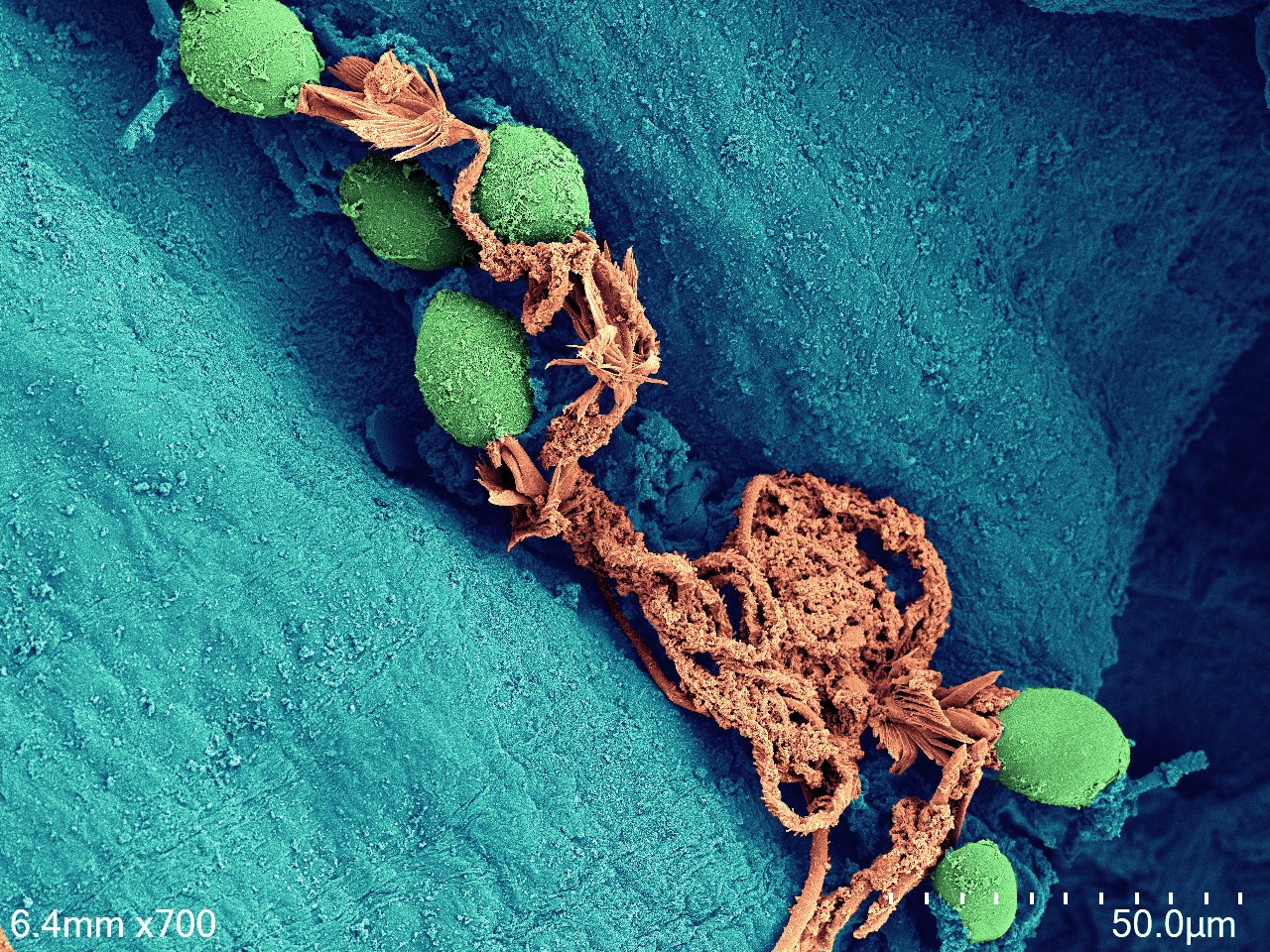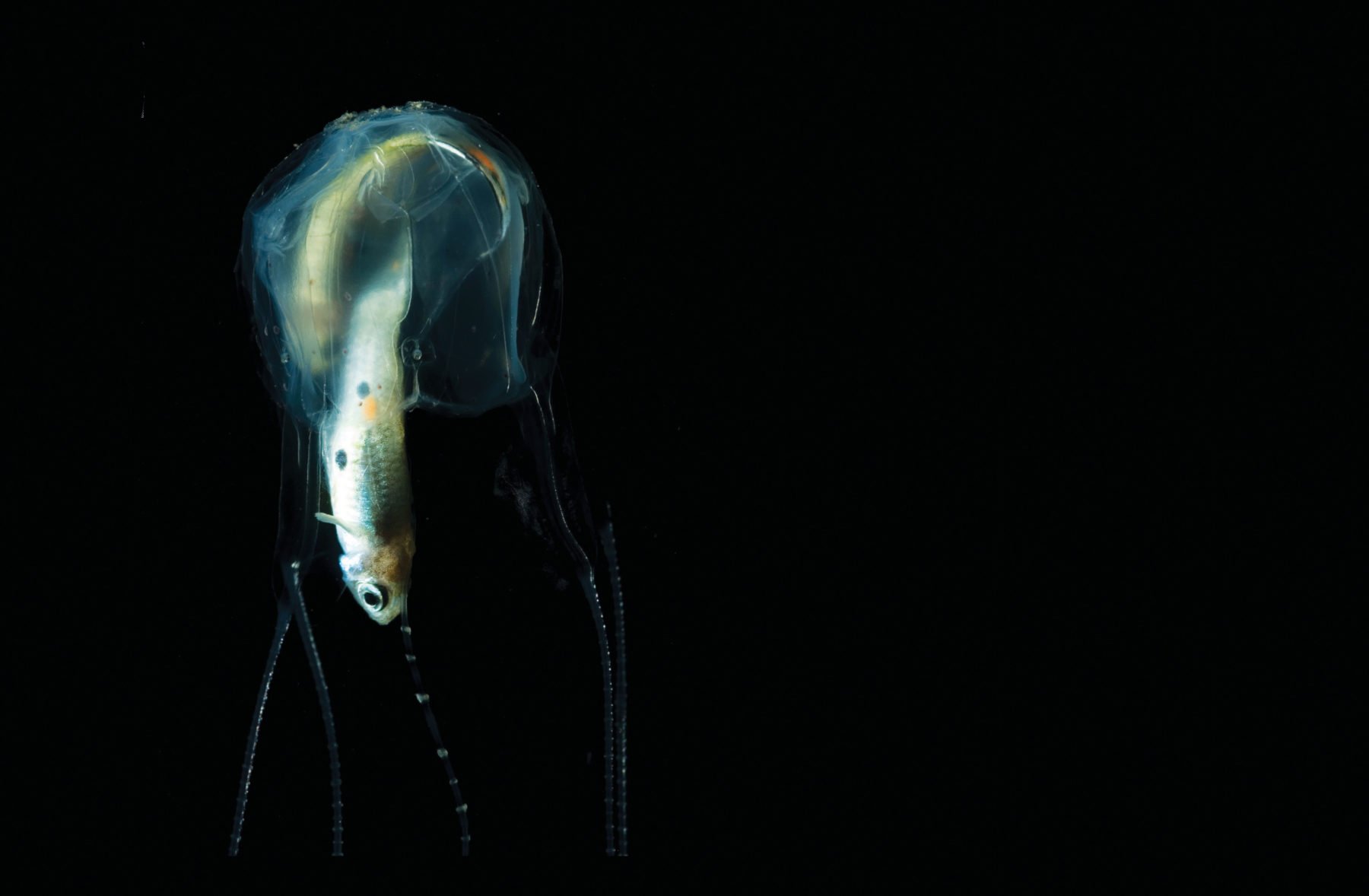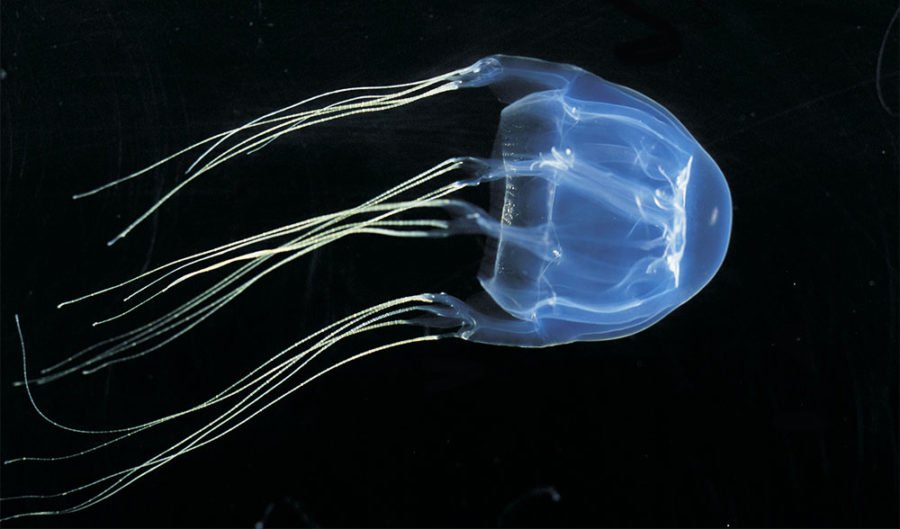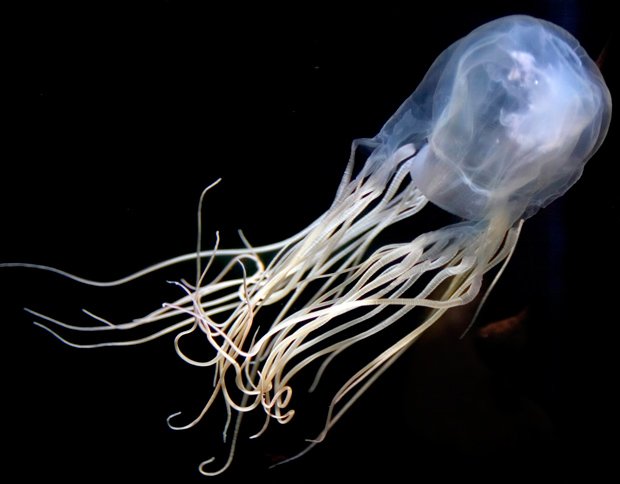Scientists have successfully hatched Irukandji eggs. Here’s why that’s important

The Irukandji jellyfish could have sprung from the fertile imagination of a sci-fi horror writer. It looks deceptively insignificant and benign, but its entire body is a biological booby trap. In most jellyfish it’s only the tentacles that are studded with the minuscule harpoon-like, venom-loaded stinging cells known as nematocysts. But in Irukandji the bell is also armed with these toxic weapons – as many as 5000 per square centimetre. An encounter with an Irukandji can have an adult human soon fighting for their life. Like most jellyfish, the Irukandji is transparent, but it’s tiny – no more than 2.5cm wide – so you’re unlikely to see it coming and stay out of its way. And even if you did, those tentacles are extendable, reaching out to four times their relaxed length.
This jellyfish was named after the Irukandji people, traditional fishers whose Country includes the sea off the coastal regions near Cairns, Queensland. Although this was the area where the jellyfish was first recognised, its distribution is much wider. And with more people venturing into the waters where they occur, reports of stings are becoming increasingly common and scientific scrutiny of the Irukandji has been mounting.
But research on the species in the wild has had limitations. Although it’s been possible to collect these tiny, near-invisible creatures in their natural habitat at night using lights, scientists have been struggling to study them in a controlled laboratory environment and haven’t been able to breed them in captivity.
Now in a world-first, Professor Jamie Seymour and his team of jellyfish researchers working in a lab dubbed the eduQuarium at James Cook University’s Cairns campus have managed to breed the Irukandji in captivity. It’s an achievement that’s been 20 years in the making and is a vital step forward in the mitigation of the threat posed by this intriguing jellyfish species.
It also means that we finally have a chance to learn the secrets of a creature that produces one of the most diabolically painful experiences known to humans.
Irukandji–human encounters
Jamie Seymour is a global expert on jellyfish, as well as many other dangerous sea creatures. Protected in tanks stretching around the walls of his lab is a range of deadly marine animals, from colourful crustaceans that literally punch their prey into submission, to slimy snails with weapons stuffed up their noses and sand assassins with blade-like claws that would make Freddy Krueger cower.
But it’s the Irukandji jellyfish that are the stars of this show in their futuristic round tanks, designed without corners to prevent damaging the soft bodies of these hard-core carnivores.
Jamie understands the pain of an Irukandji sting better than most. It’s one of the risks of his research and he’s been stung 11 times so far. “Yep, I’ve experienced the pain of an Irukandji sting many times in the past. It’s not something I’m proud of and it’s 11 mistakes I wish I hadn’t made,” he admits. “So on a more positive note, at least I’m intimately familiar with the incredible pain and discomfort that victims can suffer, and I wouldn’t wish it on my worst enemy.”
As with many things about this poorly understood jellyfish, its lethal weaponry of explosive and spring-loaded venomous harpoons is unique in the animal kingdom. Certainly people have died following envenomation by Irukandji, with victims succumbing to the effects of potent toxins and incredible pain, but it’s rare. There are only two recorded deaths.
But there’s concern that these jellyfish may have been responsible for more deaths than those attributed directly to them and that for various reasons, including the impact of climate change on their distribution,
Irukandji–human encounters are on the rise. And that’s what makes the discovery of how to breed them so important.
Irukandji have separate sexes and making ‘jelly babies’ is complex. Scientists still don’t know exactly how the sexes hook up in the wild – perhaps by aggregating, by following some chemical or environmental cue or just meeting by chance. But when they do, boy sheds sperm, girl sheds eggs and, if the stars align, the eggs are fertilised and hatch into larvae with eye spots, known as planulae.

After floating in the plankton, planula larvae settle onto a substrate, where each morphs into a polyp, parts of which bud off to eventually become free-swimming adult jellies, which are known as medusae.
Researchers have previously been successful in collecting these adults and getting them to spawn. But they couldn’t get the eggs to hatch, until now. Team member Dr Rob Courtney solved the problem with patience and a little bit of luck.
Initial efforts to breed Irukandji were based on the development and hatching timeframes of jellies, which usually take less than three weeks. Using this as a model yielded no success, so Rob extended the observation period. What he discovered was remarkable. The eggs of the Irukandji jellyfish could enter a dormant phase and take up to six months to hatch. What triggers the eggs to hatch is still unknown, although light, water temperature and other environmental cues have been hypothesised and are currently being tested.
For the first time in the world, the team is now successfully breeding its own family of deadly jelly babies, which will allow the expansion of research into understanding Irukandji feeding ecology and the species’ environmental thresholds of temperature and salinity. And that’s expected to allow us to better predict when and where Irukandji are likely to occur.
It will also increase our understanding of the effects on the species of climate change, which is extending the dangerous creatures’ distribution range further south. Irukandji are no longer only a problem of the warmer tropical waters of northern
Queensland. They are occurring as far south as K’gari (Fraser Island) and Mooloolaba, just north of Brisbane. Data collected by Jamie’s team will assist jellyfish management and education efforts to keep people safe while swimming.
Although the number of stings is still relatively low, the potential public health implications are huge if numbers rise, as is expected with a predicted southerly expansion of the deadly jellyfish. Already, almost 100 per cent of Irukandji stings require hospitalisation, and often medical evacuation by helicopter. There could be severe financial consequences to coastal communities who depend heavily on tourism should sting rates increase.
Irukandji syndrome
The term Irukandji syndrome was coined in the 1950s by doctor and nature historian Hugo Flecker to describe a set of inexplicable symptoms seen at the time in a number of swimmers. However, it was pathologist Jack Barnes who found that the cause of this syndrome was a tiny little box jellyfish that he discovered. It would later become his scientific namesake, Carukia barnesi, and the species commonly known as the Irukandji.
How did Jack connect the dots? Perhaps recklessly, he used himself, his teenage son and a willing lifeguard as human guinea pigs, stinging all with an Irukandji. They became seriously ill but survived.
Serial sting victim Jamie Seymour says the pain isn’t felt immediately after being stung. It sneaks up to suddenly slap you in the face. Then you experience nausea and breathing difficulties, and your entire body becomes riddled with pain. It feels, he says, like having an elephant sitting on your chest and you experience a sense of impending doom. Other symptoms include vomiting, severe headaches, fluid in the lungs, cardiac failure and a severe rise in blood pressure, ultimately resulting in death in some cases.
Scientists have now also discovered that other species of jellyfish, most notably other cubozoans or box jellyfish (of which Irukandji is one of the smallest) also give rise to this syndrome. There are at least 8–12 other species of Irukandji jellyfish found in Australian waters. Most have been documented in the warmer waters of the east coast. Research has revealed that they also like to extend their tentacles and have caused injury in other parts of the world. Unfortunately there are no definitive tests that can confirm if patients are the victims of Irukandji stings. Treatment of the cryptic syndrome is also complex due to the varying symptoms, so it’s easy to misdiagnose.
While developing an antivenom sounds obvious, doing so will be expensive and take years. It’s also complicated given the number of species that cause the syndrome and their different venom profiles, so it’s not likely to be a one-antivenom-fits-all scenario.
To date the only failsafe treatment is prevention – adhering to warning signs, avoiding the water during peak seasons (which vary with location), wearing stinger suits or avoiding the ocean altogether in favour of the local swimming pool.


Active predators
It’s a misconception that jellies float randomly around the oceans. Some, such as the Irukandji, are active predators. An adult has four tentacles, one hanging off each corner of its box-shaped bell. These can be 40 times the length of the body – up to 1m long – and can expand and contract.
Dotted along the tentacles are tightly packed bundles of venom-loaded nematocysts that are used like lures. The Irukandji extends its tentacles and twitches them to attract fish, like jigging for squid to attract prey. Anything unfortunate enough to take the bait receives a face full of venom. Once the prey is captured, the tentacles quickly contract; the prey is pulled into the mouth and stomach, pre-digested, propelled down the hollow tentacles, absorbed, and passed out through the other end. They have four of these tentacles, and so four bums, or exits, for waste.
Irukandji only fish during daylight hours and their arms contract at night when there is no use fishing because prey can’t see the deadly bait (the nematocysts) on offer. Larger specimens twitch their tentacles more frequently than small specimens. The hypothesis is that as they get bigger, they need to eat more and attract bigger prey.
Finding out exactly what they prey on at which stage of their life cycle is also important for keeping these deadly captive jelly babies alive. “There are so many unknowns with the Irukandji and diet is one,” explains aquarist Sally Turner, a research assistant in Jamie’s lab. “Some foods they won’t touch, or they’ll spit back out, while others change the opacity of the jellies’ body. It’s like trying to develop a menu for fussy children.”
So far, it’s been a matter of trial and error with lashings of patience. Solving these puzzles will help build a picture of how these jellyfish survive and other factors that can potentially influence where they’re found.

As well as the tentacles, the Irukandji’s 2.5cm-wide body is packed with nematocysts. Each comprise a venom sac attached to a barbed hollow thread coiled up inside a capsule. The capsule is covered with spikes that trigger the nematocyst to fire when it encounters a biological surface, such as prey. It’s one of the fastest recorded biological processes known. The venom is delivered down the shaft of the nematocysts into the victim literally before they’ve blinked an eye.
PhD student Emily O’Hara travelled from the other side of the world to join the jelly team and study the lethality of the Irukandji’s nematocysts. “When I first looked at the nematocysts, I wasn’t expecting to see such complexity. For an animal that doesn’t have a brain it’s incredibly sophisticated in everything it does, even down to the microscopic level. This no doubt helps to explain why it’s such a formidable predator.”
What the team has also discovered is that not all nematocysts are created equal. There are different nematocysts for different functions, and all have different venom profiles. Notably, nematocysts in the bell are different from those in the tentacles and scientists are still trying to determine why.
Irukandji are venomous at all stages of their life cycle. However the venom changes as they get older and transition from their early diet of invertebrates to vertebrates. It’s because we’re vertebrates that we humans are susceptible to the venom if we encounter them.
Variations in venom profiles also vary between the tentacles, the bell and different geographic locations. It now seems that the more the research of Jamie and his team reveals, the more questions it raises. Will ocean warming change the venom profiles of Irukandji, and how will this influence symptoms of stings, potential treatments, safety and management strategies? Being forearmed with answers will ensure the best public health response and, hopefully, that the death rate from Irukandji stings can also be kept low.



